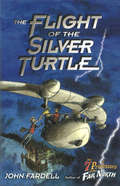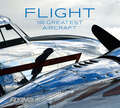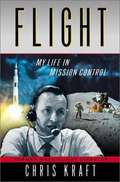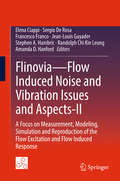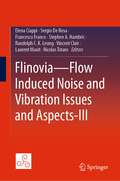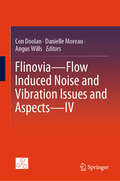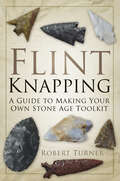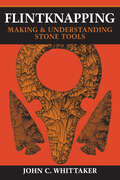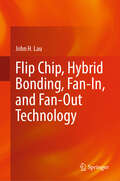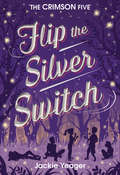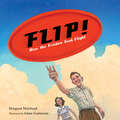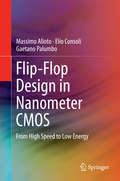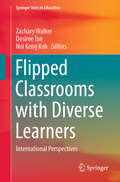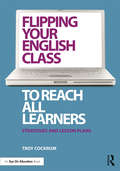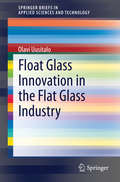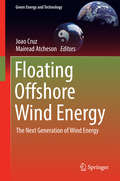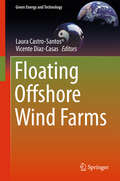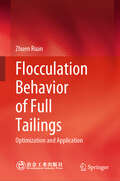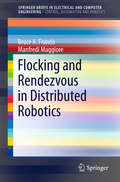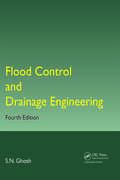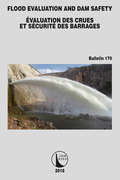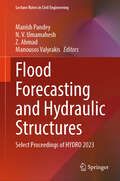- Table View
- List View
Flight of the Silver Turtle
by John FardellThe take-charge kids from John Fardell's The 7 Professors of the Far North face a summer packed with danger, excitement and suspense--flying airplanes, scuba diving, cracking codes and even taking a spin in the world's first antigravity backpack as they plunge into this fast-paced, high- flying adventure. Ben, Zara, Sam and Marcia begin their summer vacation by helping Professor Ampersand build the Silver Turtle, a high-tech airplane. This is thrilling enough, but things take an even wilder turn when a strange woman steals the airplane with the kids inside. She's trying to evade members of Noctarma, an international criminal organization that thinks the airplane is carrying a secret antigravity device that could be the key to world domination. They've got the wrong Silver Turtle, but they've also captured Professor Ampersand--and the kids will have to pull out all the stops to find the real Silver Turtle device before Noctarma does.
Flight: 100 Greatest Aircraft
by Mark PhelpsFacts, photos, stories, and specs of one hundred remarkable flying machines, from the Sopwith Camel to the 747 to the supersonic F-22 Raptor. Of all humanity&’s dazzling innovations, perhaps none captures our imaginations or fuels our inventive spirits as much as flight. In our quest to soar higher, faster, and farther, we&’ve dreamed up airborne wonders that are a sight to behold—like the supersonic F-22 Raptor, stealthily soaring above the clouds, or the Boeing-Stearman PT-17 Biplane, the beautiful starter model that helped a generation earn their wings, or the deluxe Concorde—the first passenger jet to cruise at the speed of sound. These iconic aircraft—and ninety-seven more stunning feats of aeronautical engineering—make up the world&’s most groundbreaking contributions to flight, all curated and collected here by the experts at Flying magazine. In Flight: 100 Greatest Aircraft, there&’s something for every aviation aficionado—from brazen stunt planes to far-from-pedestrian commercial jets, from military marvels to spacecraft that reached dazzling new heights. With its spectacular full-color photographs, fascinating and informative text, and a detailed specifications section, Flight is the essential book for pilots and plane-lovers everywhere.
Flight: My Life in Mission Control
by Chris KraftFlight is the stirring account of the U.S. space program from its infancy to its greatest triumphs - written by the one man who was there for it all, Christopher Columbus Kraft, Jr., the first NASA flight director.
Flinovia—Flow Induced Noise and Vibration Issues and Aspects-II: A Focus on Measurement, Modeling, Simulation and Reproduction of the Flow Excitation and Flow Induced Response
by Jean-Louis Guyader Stephen A. Hambric Elena Ciappi Sergio De Rosa Francesco Franco Randolph Chi Kin Leung Amanda D. HanfordThis is the proceedings of the Second International Workshop on Flow Induced Noise and Vibration (FLINOVIA), which was held in Penn State, USA, in April 2016. The authors’ backgrounds represent a mix of academia, government, and industry, and several papers include applications to important problems for underwater vehicles, aerospace structures and commercial transportation. The book offers a valuable reference guide for all those working in the area of flow-induced vibration and noise.Flow induced vibration and noise (FIVN) remains a critical research topic. Even after over 50 years of intensive research, accurate and cost-effective FIVN simulation and measurement techniques remain elusive. This book gathers the latest research from some of the most prominent experts in the field.The book describes methods for characterizing wall pressure fluctuations, including subsonic and supersonic turbulent boundary layer flows over smooth and rough surfaces using computational methods like Large Eddy Simulation; for inferring wall pressure fluctuations using inverse techniques based on panel vibrations or holographic pressure sensor arrays; for calculating the resulting structural vibrations and radiated sound using traditional finite element methods, as well as advanced methods like Energy Finite Elements; for using scaling approaches to universally collapse flow-excited vibration and noise spectra; and for computing time histories of structural response, including alternating stresses.
Flinovia—Flow Induced Noise and Vibration Issues and Aspects-III
by Stephen A. Hambric Elena Ciappi Sergio De Rosa Francesco Franco Randolph C. K. Leung Vincent Clair Laurent Maxit Nicolas TotaroThis volume gathers the latest advances and innovations in the field of flow-induced vibration and noise, as presented by leading international researchers at the 3rd International Symposium on Flow Induced Noise and Vibration Issues and Aspects (FLINOVIA), which was held in Lyon, France, in September 2019. It explores topics such as turbulent boundary layer-induced vibration and noise, tonal noise, noise due to ingested turbulence, fluid-structure interaction problems, and noise control techniques. The authors’ backgrounds represent a mix of academia, government, and industry, and several papers include applications to important problems for underwater vehicles, aerospace structures and commercial transportation. The book offers a valuable reference guide for all those interested in measurement, modelling, simulation and reproduction of the flow excitation and flow induced structural response.
Flinovia—Flow Induced Noise and Vibration Issues and Aspects—IV
by Danielle Moreau Con Doolan Angus WillsThis book gathers the latest advances and innovations in the field of flow-induced vibration and noise, as presented by leading international researchers at the 4th International Symposium on Flow-Induced Noise and Vibration Issues and Aspects (FLINOVIA), which was held in Sydney, Australia, in May 2023. It explores topics such as turbulent boundary layer-induced vibration and noise, noise due to ingested turbulence, rotor noise, fluid-structure interaction problems, innovative measurement methods, and noise control techniques. The authors’ backgrounds represent a mix of academia, government, and industry, and several papers include applications to important problems for underwater vehicles, aerospace applications, and commercial transportation. The book offers a valuable reference guide for all those interested in measurement, modelling, simulation, and reproduction of the flow excitation and flow-induced structural response.
Flint Knapping: A Guide to Making Your Own Stone Age Toolkit
by Robert TurnerFlint knapping, which is the shaping of flint or other fracturing stone to manufacture tools, was one of the primary skills used for survival by our prehistoric ancestors. Early mankind once made and used these implements on a daily basis to hunt, prepare food and clothing, to farm, make shelters, and perform all the other tasks required for Stone Age existence.A material that has been with us since earliest times, flint still plays a part in our lives today: it is used in cigarette, gas and barbeque lighters; in some parts of Britain it is a major building material; and many of our beaches have shingle which is just flint by another name.In this informative and original guide, expert Robert Turner explains how flint was used, what tools were made and what they were made for, and provides detailed instruction of how to make them, enabling the reader to replicate their own Stone Age toolkit. Illustrated throughout, Flint Knapping is a journey of archaeological discovery through the Palaeolithic, Mesolithic, Neolithic and Bronze Ages.
Flintknapping: Making & Understanding Stone Tools
by John C. WhittakerA detailed, practical guide to the ancient craft of making stone tools, featuring an archaeological analysis.Flintknapping is an ancient craft enjoying a resurgence of interest among both amateur and professional students of prehistoric cultures. In this guide, John C. Whittaker offers the most detailed handbook on flintknapping currently available and the only one written from the archaeological perspective of interpreting stone tools as well as making them.Flintknapping contains detailed, practical information on making stone tools. Whittaker starts at the beginner level and progresses to discussion of a wide range of techniques. He includes information on necessary tools and materials, as well as step-by-step instructions for making several basic stone tool types. Numerous diagrams allow the reader to visualize the flintknapping process, and drawings of many stone tools illustrate the discussions and serve as models for beginning knappers.Written for a wide amateur and professional audience, Flintknapping will be essential for practicing knappers as well as for teachers of the history of technology, experimental archaeology, and stone tool analysis.“A mid-range user’s guide to flintknapping is long overdue. There have been some admirable attempts to produce such a volume, but these have been targeted at specific, fairly narrow audiences. Not so with Flintknapping. . . . [Whittaker’s] clear aim is to reach professional archaeologists as well as hobbyists. I believe he achieves this goal with incredible skill and humor. . . . I highly recommend this book to everyone interested in flintknapping.” —Plains Anthropologist“Very attractive to readers interested in ancient crafts, survival skills, or the history of technology . . . . Far superior to anything currently available.” —James C. Woods, director, The Herrett Museum, College of Southern Idaho
Flip Chip, Hybrid Bonding, Fan-In, and Fan-Out Technology
by John H. LauThis book focuses on the design, materials, process, fabrication, and reliability of flip chip, hybrid bonding, fan-in, and fan-out technology. Both principles and engineering practice have been addressed, with more weight placed on engineering practice. This is achieved by providing in-depth study on a number of major topics such as wafer bumping, flip chip assembly, underfill and reliability, chip-to-wafer, wafer-to-wafer, Cu-Cu hybrid bonding, WLCSP, 6-side molded WLCSP, FOWLP such as hybrid substrates with PID, ABF, and ultra-large organic interposer, the communications between chiplets and heterogeneous integration packaging, and on-board optics, near-package optics, and co-packaged optics.The book benefits researchers, engineers, and graduate students in the fields of electrical engineering, mechanical engineering, materials sciences, industry engineering, etc.
Flip the Silver Switch (The Crimson Five #2)
by Jackie YeagerThe Crimson Five are headed to the Piedmont Global Championships in Quebec, where they'll compete against the best inventor teams in the world. Kia and her New York teammates are excited to share a new amazing invention — but they're blind-sided with another task to solve, with just two weeks to do it!As the team struggles with a lack of creativity, rumors leave The Crimson Five questioning everything about each other. Kia knows she and her team must come together like never before in order to win a coveted spot on the Swirl and Spark Creativity Tour, but tragedy threatens to derail all that they've built.The Crimson Five are together again.Because sometimes it takes a whole team to help you see things clearly.
Flip! How the Frisbee Took Flight
by Margaret MuirheadThis charming picture book biography about the inventor of the Frisbee follows the twists and turns of innovation and highlights the persistence it takes to succeed. Fred Morrison is credited with inventing this classic toy, but for centuries folks have been flipping for flying discs. Ancient Greeks flicked discs, and beginning in the 1920s, college kids at Yale University were tossing pie tins. Fred's invention quest began in 1932 after tossing a tin popcorn lid around the backyard. For more than twenty years, Fred and his wife, Lu, tried and failed to perfect a flying-disc concept. Eventually they created what we know today as the Frisbee. Fun and fact-filled, this Frisbee origin story is sure to delight sports and STEM fans alike.
Flip-Flop Design in Nanometer CMOS
by Massimo Alioto Elio Consoli Gaetano PalumboThis book provides a unified treatment of Flip-Flop design and selection in nanometer CMOS VLSI systems. The design aspects related to the energy-delay tradeoff in Flip-Flops are discussed, including their energy-optimal selection according to the targeted application, and the detailed circuit design in nanometer CMOS VLSI systems. Design strategies are derived in a coherent framework that includes explicitly nanometer effects, including leakage, layout parasitics and process/voltage/temperature variations, as main advances over the existing body of work in the field. The related design tradeoffs are explored in a wide range of applications and the related energy-performance targets. A wide range of existing and recently proposed Flip-Flop topologies are discussed. Theoretical foundations are provided to set the stage for the derivation of design guidelines, and emphasis is given on practical aspects and consequences of the presented results. Analytical models and derivations are introduced when needed to gain an insight into the inter-dependence of design parameters under practical constraints. This book serves as a valuable reference for practicing engineers working in the VLSI design area, and as text book for senior undergraduate, graduate and postgraduate students (already familiar with digital circuits and timing).
Flipped Classrooms with Diverse Learners: International Perspectives (Springer Texts in Education)
by Noi Keng Koh Zachary Walker Desiree TanThis book addresses the background of classroom flipping, explores the theoretical underpinnings for why flipping works, and shares current success stories in practice. It provides diverse international examples of classroom flipping for all ages, includes discussions of the authors’ studies in the context of the existing research, and illustrates the impact that classroom flipping has had across a range of educational settings instead of focusing on a specific domain or learner context. Intended as a handbook for practitioners, the analysis of commonly used, highly effective techniques for learners of various ages fills a major gap in the literature. It offers a valuable resource for educators, helping them make the flipped learning experience an impactful and meaningful one.
Flipping Your English Class to Reach All Learners: Strategies and Lesson Plans
by Troy CockrumLearn how flipping your English language arts classroom can help you reach students of different abilities, improve classroom management, and give you more time to interact with each student. This practical book shows why flipped classrooms are effective and how they work. You will find out how to flip your instruction in writing, reading, language, and speaking and listening while meeting the Common Core State Standards. A variety of step-by-step lesson plans are provided.
Float Glass Innovation in the Flat Glass Industry
by Olavi UusitaloA thorough industry analysis is of utmost importance for a study on the impact of technological changes on industry structure. This book evaluates the consequences of a vaguely chosen level of an industry analysis. Too broad a definition of the industry may disaggregate sub-industries, processing industries and international aspects. This is illustrated by revisiting an industry study upon which the dominant design model was based. Readers will see and understand the consequences of too broadly defined industries together with quantitative research approach can have. The book argues that the nature of the industry should define the level of the analysis. This is done by revisiting the flat glass industry study, on which Anderson and Tushman's (1990) dominant design model is partly based. In their study Anderson and Tushman defined the flat glass industry based on four-digit SIC codes. It is argued that this definition was too broad and it disaggregated important sub-industries, processing industries and international aspects. This study uses more accurate analysis in five-digit SIC codes. The empirical findings of this study and Anderson and Tushman's study are different. Their broader industry definition revealed only the flat glass industry not two sub-industries: plate glass and sheet glass. According to this study the nature of the industry should define the level of the analysis and performance parameter should defined be based on effectiveness instead of efficiency of the innovation. As a consequence of these clarifications this study regards contrary to Anderson and Tushman float glass as the dominant design.
Floating Offshore Wind Energy
by Joao Cruz Mairead AtchesonThis book provides a state-of-the-art review of floating offshore wind turbines (FOWT). It offers developers a global perspective on floating offshore wind energy conversion technology, documenting the key challenges and practical solutions that this new industry has found to date. Drawing on a wide network of experts, it reviews the conception, early design stages, load & structural analysis and the construction of FOWT. It also presents and discusses data from pioneering projects. Written by experienced professionals from a mix of academia and industry, the content is both practical and visionary. As one of the first titles dedicated to FOWT, it is a must-have for anyone interested in offshore renewable energy conversion technologies.
Floating Offshore Wind Farms
by Laura Castro-Santos Vicente Diaz-CasasThis book provides an overview of floating offshore wind farms and focuses on the economic aspects of this renewable-energy technology. It presents economic maps demonstrating the main costs, and explores various important aspects of floating offshore wind farms. It examines topics including offshore wind turbines, floating offshore wind platforms, mooring and anchoring, as well as offshore electrical systems. It is a particularly useful resource in light of the fact that most water masses are deep and therefore not suitable for fixed offshore wind farms. A valuable reference work for students and researchers interested in naval and ocean engineering and economics, this book provides a new perspective on floating offshore wind farms, and makes a useful contribution to the existing literature.
Flocculation Behavior of Full Tailings: Optimization and Application
by Zhuen RuanThis book focuses on the flocculation behavior of full tailings, analyzes the influence of multiple factors such as flow field shear on flocculation behavior, constructs a dynamic model of full tailings flocculation behavior, simulates and studies the flocculation behavior of full tailings in the feedwells of deep cone thickener, and optimizes the feeding and internal flocculation parameters. This book can be read by researchers, designers, and engineering technicians related to backfill mining, as well as by teachers and students of mining majors in universities.
Flocculation in Natural and Engineered Environmental Systems
by Ian G. Droppo Gary G. Leppard Steven N. Liss Timothy G. MilliganWhile new developments in genomics, nanotechnology, sampling, and modelling permit increasingly revealing investigation into flocculation structure and processes, there is still a fundamental lack of knowledge related to many aspects of this phenomenon. Presented by a prominent team of international experts, this text takes a unique perspective and melds together the natural and engineering fields of science as they relate to this central phenomenon. In doing so, the authors present the full range of sampling, handling, analytical, and interpretive options for operational management of natural or engineered system, providing comprehensive coverage that meets the needs of researchers, practitioners and students.
Flocking and Rendezvous in Distributed Robotics
by Bruce A. Francis Manfredi MaggioreThis brief describes the coordinated control of groups of robots using only sensory input - and no direct external commands. Furthermore, each robot employs the same local strategy, i. e. , there are no leaders, and the text also deals with decentralized control, allowing for cases in which no single robot can sense all the others. One can get intuition for the problem from the natural world, for example, flocking birds. How do they achieve and maintain their flying formation? Recognizing their importance as the most basic coordination tasks for mobile robot networks, the brief details flocking and rendezvous. They are shown to be physical illustrations of emergent behaviors with global consensus arising from local interactions. The authors extend the consideration of these fundamental ideas to describe their operation in flying robots and prompt readers to pursue further research in the field. Flocking and Rendezvous in Distributed Robotics will provide graduate students a firm grounding in the subject, while also offering an authoritative reference work for more experienced workers seeking a brief but thorough treatment of an area that has rapidly gained in interest.
Flood Control Management for the City and Surroundings of Jeddah, Saudi Arabia
by Mashael Mohammed Al SaudDuring the past years, Saudi Arabia has been affected by particularly severe torrential rains and floods. This book presents an in-depth and all-encompassing study on the floods that occurred in the Jeddah area in 2009 and 2011, including water-flow mechanisms, state-of-the-art techniques for flood assessment, flood control and appropriate management approaches. It highlights a number of methods and concepts that can be applied in similar areas in Saudi Arabia in order to reduce and mitigate the impact of torrential rains and floods.
Flood Control and Drainage Engineering
by S.N. GhoshPrimarily written as course material on flood control and drainage engineering for advanced students of civil engineering, this new fourth edition is again thoroughly revised. It accommodates recent developments in remote sensing, information technology and GIS technology. New added material deals with flood management due to Tsunami waves, floodin
Flood Damage Assessment and Management (Water Science and Technology Library #94)
by Martina Zeleňáková Lenka Gaňová Daniel Constantin DiaconuThis book presents state-of-the-art, essential methods and tools for flood risk assessment and management. The costs of damage caused by extreme weather events, among which floods are a major category, are rapidly rising, both globally and across Europe. The scope and scale of flood episodes point to the need for comprehensive proposals, including the implementation of flood protection measures in areas exposed to flood risk. This book is dedicated to flood damage assessment, and addresses the management of social, economic and environmental damage. It develops a general methodology for flood risk assessment and presents a range of effective flood protection methods in keeping with the objectives of flood risk management. As such, it offers a valuable resource for young researchers, academics, lecturers and water management practitioners alike.
Flood Evaluation and Dam Safety (ICOLD Bulletins Series #170)
by Nathalie SchaunerHydrology and dams are two fields that are obviously closely related. Four bulletins have so far been published by the Committee: Selection of Design Flood – Current methods, Dams and Floods – Guidelines and cases histories, Role of Dams in Flood Mitigation – A review and Integrated Flood Management. These bulletins have essentially addressed floods, the risks they represent and their significance for the concerned populations. The present Bulletin deviates slightly from this path, adopting a somewhat more technical perspective. The text consists of three chapters, conceived to be accessible to the practitioners.
Flood Forecasting and Hydraulic Structures: Select Proceedings of HYDRO 2023 (Lecture Notes in Civil Engineering #546)
by Manish Pandey N. V. Umamahesh Z. Ahmad Manousos ValyrakisThis book presents the select proceedings of the 28th International Conference on Hydraulics, Water Resources, River and Coastal Engineering (HYDRO 2023) focusing on broad spectrum of emerging opportunities and challenges in the field of flood forecasting and hydraulic structures. It covers a range of topics, including early warning system, urban flood modelling and management, dam hazard classification, river training and protection works, and structural and non-structural measures for flood mitigation, assessment, and development of flood vulnerability. The book also presents latest developments in topics such as hazard and risk maps rehabilitation of old dams, streamflow turbines, canal operation and related structure, and operation and management of dams, including their instrumentation. Presenting recent advances in the form of illustrations, tables, and text, it offers readers insights for their own research. In addition, the book addresses fundamental concepts and studies in the field of flood forecasting and hydraulic structures, making it a valuable resource for both beginners and researchers wanting to further their understanding of hydraulics, water resources, and coastal engineering.
